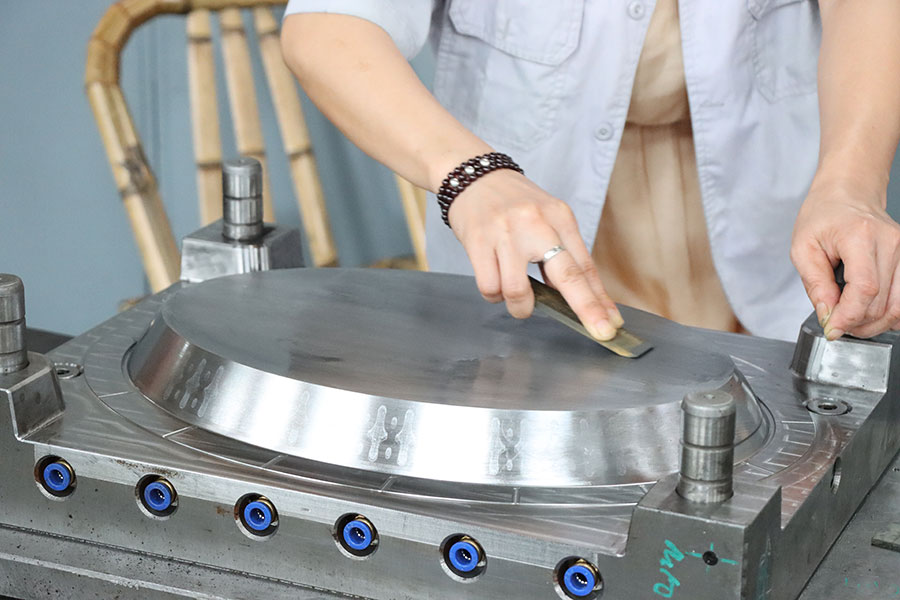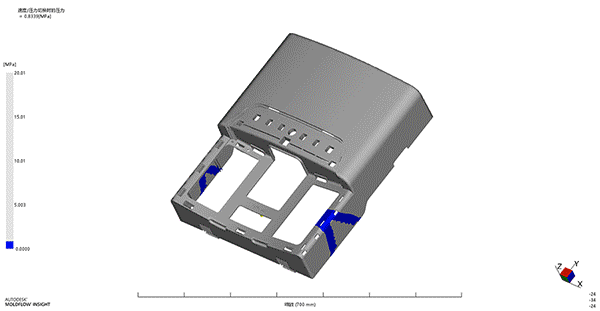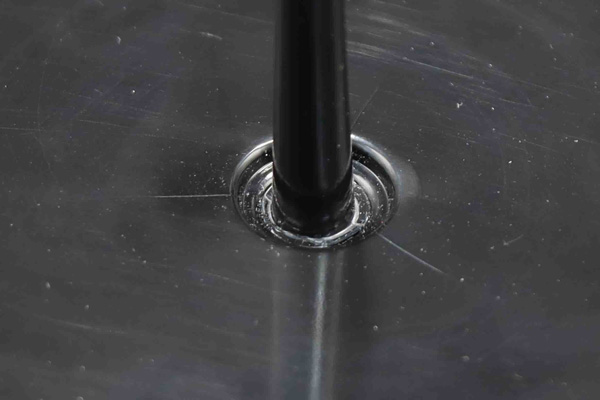
Why is Mold Fabrication So Challenging to Learn? - Prototool - plastic injection
Author:gly Date: 2024-10-15
2. the syringe needle is too high, resulting in local glue bit is too thin, the periphery of the first fill, to the center of the intersection to produce fusion line.
Tonnage of Machine: When injecting ABS plastic, the injection volume per shot is only 75% of the standard injection volume.
The viscosity of ABS molten parts is higher than that of polystyrene or modified polystyrene, so a higher injection pressure is used during injection. Of course, not all ABS parts need to be injected at high pressure, but small, simple and thick parts can be injected at a lower pressure. During the injection process, the pressure in the cavity at the moment of gate closure often determines the surface quality of the product and the degree of silver wire defects. If the pressure is too low, the plastic shrinks and has a greater chance of disengaging from the cavity surface, resulting in a hazy surface. Pressure is too large, the plastic cavity surface friction is strong, easy to cause sticky mold.
1.The holding pressure is too large, the internal stress is large, and the deformation is large within 24h after leaving the mold.
ABS plastic is hygroscopic and sensitive to moisture, sufficient drying and preheating before processing, not only to eliminate water vapor caused by the surface of the product smoky bubble, silver, but also help plasticization, reduce the surface color of the parts and cloud pattern. ABS raw materials to control the moisture below 0.13%. The drying conditions before injection are: 2~3h at 75~80℃ during the dry season or winter, 4~8h at 80~90℃ during the rainy days in summer, and longer drying time of 8~16h if the parts have to achieve a particularly good gloss or the parts themselves are complicated. It is advisable to convert the hopper of the machine into a hot air hopper dryer so that the dried ABS does not reabsorb moisture in the hopper, but this type of hopper should be monitored for humidity to prevent overheating of the material in case of occasional interruptions in production. The proportion of recycled material should not exceed 30%, and recycled material should not be used for plating grade ABS.

6.The ejector structure is unreasonable, the ejector pin is not under the maximum clamping force, and the ejector is deformed.
The molding temperature of ABS is relatively high, and the mold temperature is also relatively high. When producing parts with large projection area, the fixed mold temperature should be 70~80℃ and the moving mold temperature should be 50~60℃. In order to shorten the production cycle and maintain the relative stability of mold temperature, cold water bath, hot water bath or other mechanical shaping method can be used to compensate for the time of cold fixing in the cavity after the parts are taken out.
Draft Angle: ≥1.5°, the draft angle not only affects the mold release, but also the appearance and assembly of the product. The side wall of plastic parts with skin pattern, sandblasting and other appearance treatment should take a draft angle of 2°~5° according to the specific situation.
4.deformation of the ejector plate or injection molding machine top stick length, resulting in unbalanced ejections and pull white.
With the detailed mold flow analysis results, the mold making and injection molding will not be much different, saving the production time and reducing the cost of production.
ABS is composed of acrylonitrile, butadiene and styrene. Acrylonitrile mainly provides chemical resistance and thermal stability; butadiene provides toughness and impact strength; and styrene provides hardness and processability for ABS. The combination of the three materials forms a comprehensive plastic.
ABS Material Type: Different ABS material, the MFI is different, which will affect the size and position of the gate runner.
Mould Cavity: Different number of cavities will affect the choice of gate position, usually the number of cavities will be selected according to the size of the injection molding machine.
When injecting ABS plastic into general injection molding machine, each injection volume is only 75% of the standard injection volume. In order to improve the quality and dimensional stability of the parts, surface gloss and uniformity of color, it is appropriate to require an injection volume of 50% of the standard injection volume.
The relationship between temperature and melt viscosity of ABS plastic is different from that of other amorphous plastics. Once it reaches the plasticization temperature (the temperature range suitable for processing, such as 220-250℃), if we continue to raise the temperature blindly, it will lead to the thermal degradation of ABS, which is not very heat resistant, and increase the melt viscosity, make injection more difficult, and decrease the mechanical properties of the parts. Therefore, although the injection temperature of ABS must be higher than that of polystyrene and other plastics, it cannot have a more relaxed temperature range like the latter. In some injection molding machines with poor temperature control, when a certain number of ABS parts are produced, more or less yellow or brown coke particles are found embedded in the parts, and it is difficult to remove them by adding new material to the empty injection. The reason for this is that ABS plastics contain butadiene, which causes degradation and carbonization when a plastic particle adheres firmly to some hard-to-wash surface in the screw tank at high temperatures and is subjected to prolonged high temperatures. Since high temperature operation can be a problem for ABS, it is necessary to limit the furnace temperature in each section of the barrel. Of course, the applicable furnace temperature varies for different types and compositions of ABS. For example, for plunger type machines, the furnace temperature is maintained at 180-230°C; for screw machines, the furnace temperature is maintained at 160-220°C. In particular, it is worth mentioning that ABS is sensitive to changes in various process factors due to its high processing temperature. Therefore, the temperature control of the front end of the barrel and the nozzle part is very important. It has been proven that any small change in these two parts will be reflected in the part. The greater the temperature variation, the greater the defects such as fusion seam, poor gloss, flying edge, sticky mold, and color change.
ACIS®, Autodesk Inventor®, CATIA® V5,Creo™ Parametric, IGES, Parasolid®, Pro/ENGINEER®,Siemens PLM Software’s NX™, SolidEdge®, SolidWorks®, STEP
Injected Molded ABS Parts have become more and more common in life. Most plastic housings are made of ABS, such as household appliances, electronic products, game consoles, water purifiers, as well as industrial exterior parts, automotive interior parts, high-end garden planters, supermarket shelves, etc.
Standard plastic injection molding machine can be used (screw L/D ratio 20:1, compression ratio more than 2, injection pressure more than 150MPa). If the use of color masterbatch or product appearance requirements are high, the use of a smaller diameter screw. The clamping force is determined according to 4700~6200t/m2, depending on the plastic grade and product requirements.
ABS material drying temperature : ABS material is hygroscopic and must be dried, drying conditions 80-90°C, 3hrs or more,
According to the complexity of the structure of the ABS product mold to do different processing arrangements, if the mold structure is simple, as long as the CNC milling, EDM processing can be completed mold, if the mold structure is more complex, will carry out a series of processing technology. For example, CNC, EDM, Deep hole Drill, Lathe, Grinding Machine, Wire-Electrode Cutting, CMM, Polish and Injection.
ABS material with medium injection speed is better. When the injection molding speed is too fast, the plastic is easy to scorch or decompose and precipitate vaporized products, so that defects such as fusion seam, poor gloss and redness of plastic near the gate appear on the parts. However, in the production of thin-walled and complex parts, it is still necessary to ensure a high enough injection molding speed, otherwise it is difficult to fill.

Shrinkage: The shrinkage rate of different sizes of ABS products will be a little different, the common range is 0.4-07%, 0.5% is recommended.

It is not easy to do a good job of ABS injection molding products, need years of experience in mold and injection molding, in product design and mold design need to do a lot of analysis, especially mold flow analysis must be done, only the design of the product in line with the mold production requirements, mold design in line with the requirements of injection molding production, so that the products made to achieve the expected results, even if the product injection are normal, but also need to do a good job in time mold Maintenance, such as checking whether the waterway is blocked, whether there is leakage of ABS material, whether the mold is touched in the production process, etc. This series of problems are well controlled to ensure that the production of ABS products is smooth, so it is very important to find a qualified ABS injection molding manufacturer.
GETTING A QUOTE WITH LK-MOULD IS FREE AND SIMPLE.
FIND MORE OF OUR SERVICES:


Plastic Molding

Rapid Prototyping

Pressure Die Casting

Parts Assembly



